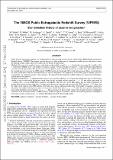Files in this item
The VIMOS Public Extragalactic Redshift Survey (VIPERS). Star formation history of passive red galaxies
Item metadata
| dc.contributor.author | Siudek, M. | |
| dc.contributor.author | Małek, K. | |
| dc.contributor.author | Scodeggio, M. | |
| dc.contributor.author | Garilli, B. | |
| dc.contributor.author | Pollo, A. | |
| dc.contributor.author | Haines, C. P. | |
| dc.contributor.author | Fritz, A. | |
| dc.contributor.author | Bolzonella, M. | |
| dc.contributor.author | de la Torre, S. | |
| dc.contributor.author | Granett, B. R. | |
| dc.contributor.author | Guzzo, L. | |
| dc.contributor.author | Abbas, U. | |
| dc.contributor.author | Adami, C. | |
| dc.contributor.author | Bottini, D. | |
| dc.contributor.author | Cappi, A. | |
| dc.contributor.author | Cucciati, O. | |
| dc.contributor.author | De Lucia, G. | |
| dc.contributor.author | Davidzon, I. | |
| dc.contributor.author | Franzetti, P. | |
| dc.contributor.author | Iovino, A. | |
| dc.contributor.author | Krywult, J. | |
| dc.contributor.author | Le Brun, V. | |
| dc.contributor.author | Le Fèvre, O. | |
| dc.contributor.author | Maccagni, D. | |
| dc.contributor.author | Marchetti, A. | |
| dc.contributor.author | Marulli, F. | |
| dc.contributor.author | Polletta, M. | |
| dc.contributor.author | Tasca, L. A. M. | |
| dc.contributor.author | Tojeiro, R. | |
| dc.contributor.author | Vergani, D. | |
| dc.contributor.author | Zanichelli, A. | |
| dc.contributor.author | Arnouts, S. | |
| dc.contributor.author | Bel, J. | |
| dc.contributor.author | Branchini, E. | |
| dc.contributor.author | Ilbert, O. | |
| dc.contributor.author | Gargiulo, A. | |
| dc.contributor.author | Moscardini, L. | |
| dc.contributor.author | Takeuchi, T. T. | |
| dc.contributor.author | Zamorani, G. | |
| dc.date.accessioned | 2017-03-24T17:30:09Z | |
| dc.date.available | 2017-03-24T17:30:09Z | |
| dc.date.issued | 2017-01 | |
| dc.identifier | 249426821 | |
| dc.identifier | 167e0d47-539f-4e88-912d-a4fc239ee45d | |
| dc.identifier | 85009433297 | |
| dc.identifier.citation | Siudek , M , Małek , K , Scodeggio , M , Garilli , B , Pollo , A , Haines , C P , Fritz , A , Bolzonella , M , de la Torre , S , Granett , B R , Guzzo , L , Abbas , U , Adami , C , Bottini , D , Cappi , A , Cucciati , O , De Lucia , G , Davidzon , I , Franzetti , P , Iovino , A , Krywult , J , Le Brun , V , Le Fèvre , O , Maccagni , D , Marchetti , A , Marulli , F , Polletta , M , Tasca , L A M , Tojeiro , R , Vergani , D , Zanichelli , A , Arnouts , S , Bel , J , Branchini , E , Ilbert , O , Gargiulo , A , Moscardini , L , Takeuchi , T T & Zamorani , G 2017 , ' The VIMOS Public Extragalactic Redshift Survey (VIPERS). Star formation history of passive red galaxies ' , Astronomy & Astrophysics , vol. 597 , A107 . https://doi.org/10.1051/0004-6361/201628951 | en |
| dc.identifier.issn | 0004-6361 | |
| dc.identifier.other | BibCode: 2017A&A...597A.107S | |
| dc.identifier.uri | https://hdl.handle.net/10023/10523 | |
| dc.description | R.T. acknowledge financial support from the European Research Council under the European Community’s Seventh Framework Programme (FP7/2007-2013)/ERC grant agreement n. 202686. | en |
| dc.description.abstract | Aims. We trace the evolution and the star formation history of passive red galaxies, using a subset of the VIMOS Public Extragalactic Redshift Survey (VIPERS). The detailed spectral analysis of stellar populations of intermediate-redshift passive red galaxies allows the build up of their stellar content to be followed over the last 8 billion years. Methods. We extracted a sample of passive red galaxies in the redshift range 0.4 Results. We find that at z ~ 1 stellar populations in low-mass passive red galaxies are younger than in high-mass passive red galaxies, similar to what is observed at the present epoch. Over the full analyzed redshift range 0.4 < z < 1.0 and stellar mass range 10 < log (Mstar/M⊙) < 12, the D4000 index increases with redshift, while HδA gets lower. This implies that the stellar populations are getting older with increasing stellar mass. Comparison to the spectra of passive red galaxies in the SDSS survey (z ~ 0.2) shows that the shape of the relations of D4000 and HδA with stellar mass has not changed significantly with redshift. Assuming a single burst formation, this implies that high-mass passive red galaxies formed their stars at zform ~ 1.7, while low-mass galaxies formed their main stellar populations more recently, at zform ~ 1. The consistency of these results, which were obtained using two independent estimators of the formation redshift (D4000 and HδA), further strengthens a scenario in which star formation proceeds from higher to lower mass systems as time passes, i.e., what has become known as the downsizing picture. | |
| dc.format.extent | 17 | |
| dc.format.extent | 1215568 | |
| dc.language.iso | eng | |
| dc.relation.ispartof | Astronomy & Astrophysics | en |
| dc.subject | Galaxies: evolution | en |
| dc.subject | Galaxies: stellar content | en |
| dc.subject | 3rd-DAS | en |
| dc.title | The VIMOS Public Extragalactic Redshift Survey (VIPERS). Star formation history of passive red galaxies | en |
| dc.type | Journal article | en |
| dc.contributor.institution | University of St Andrews. School of Physics and Astronomy | en |
| dc.identifier.doi | https://doi.org/10.1051/0004-6361/201628951 | |
| dc.description.status | Peer reviewed | en |
| dc.identifier.url | https://arxiv.org/abs/1605.05503v2 | en |
| dc.identifier.url | http://adsabs.harvard.edu/abs/2017A%26A...597A.107S | en |
This item appears in the following Collection(s)
Items in the St Andrews Research Repository are protected by copyright, with all rights reserved, unless otherwise indicated.

